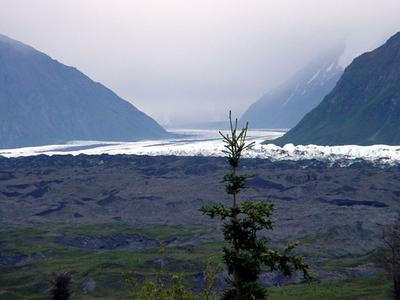26 July, 2002
Chilly last night........
The temperature dropped last night considerably from what we have
experienced here for the last week or so. I actually had to zip my sleeping
bag up for the first time. I didnšt get a chance to check the temperature
this morning, but I would estimate that it was in the upper thirties.
All of the REU students went to Palmer this morning to shower do laundry,
and pick up supplies for the coming week. Dr. Baker, Kendra, and myself
gathered up the GPR equipment and headed back up on the ice for more data
collection.
The most striking thing I noticed this morning on the ice was how slippery
it was. Hiking up went very slow because of the footing, and the heavy
loads we were carrying. We set up the GPR equipment at a different hole
than the one we have been working on. Bob Bigl, the drill operator from
CRREL, told us this hole was very clean (very little debris) for over 100m.
We repeated the procedure of lowering a single weight into the hole while
collecting radar data. Unfortunately, we were not able to get clear radar
returns off the metal weight, even after modifications and repetitions.
We packed the gear up and headed back down to the hole that I lowered
weights into on Wednesday. We collected data at the same location and over
the same profile.
Again, we were unable to get clear returns, the data may clean up a little
once it is processed though.
Once back at camp, Dr. Baker and I discussed possible reason why we were
unable to get clear radar returns. The one factor that was common for both
holes today, and different from when we first collected data was that the
water level in the holes was dramatically lower today than before. When a
radar signal passes from solid matter (ice) into air it attenuates (gets
dispersed). The weights are presently hanging in the hole at various
depths, so when the radar signal is transmitted it must pass through the
open hole before hitting the weight. The attenuation that takes place prior
to the signal hitting the weight may be enough to prevent clear returns.
This will continue to be a problem until the weights freeze into the ice,
which may or may not occur this summer.
Dr. Baker and I will sit down this evening and discuss how to proceed with
this project.
Life Is Good,
DT

The Matanuska glacier flowing north out of it's valley. The grey portion in the forground is actually part of the glacier, it's simple covered with debris. The area where I have been working can't be seen in this image, but would be just to the right hand side of what apears in the picture.
Contact the TEA in the field at
.
If you cannot connect through your browser, copy the
TEA's e-mail address in the "To:" line of
your favorite e-mail package.
|
